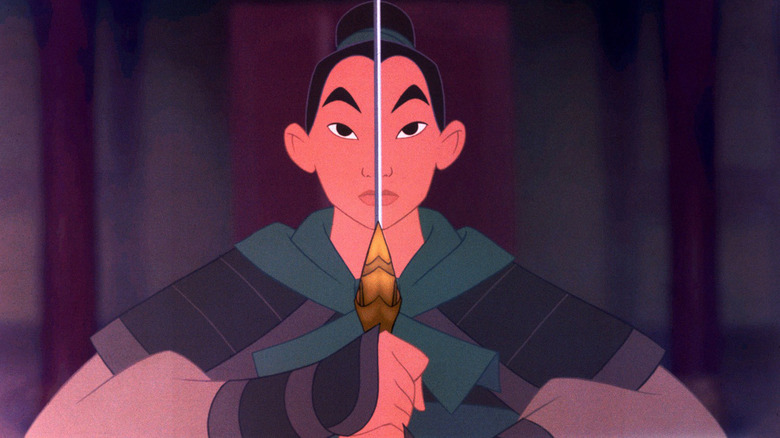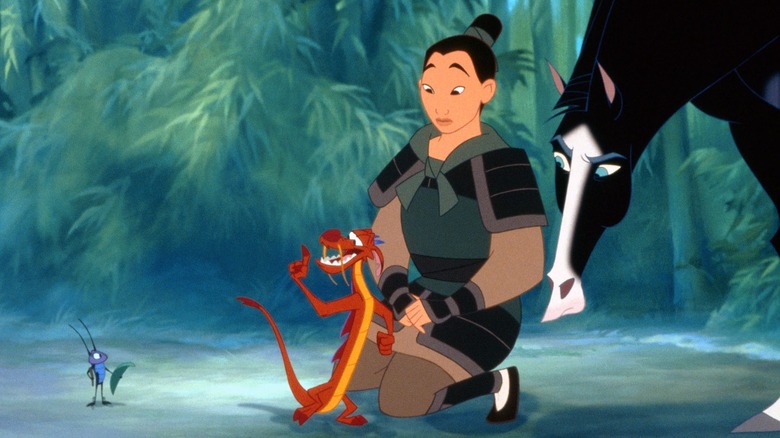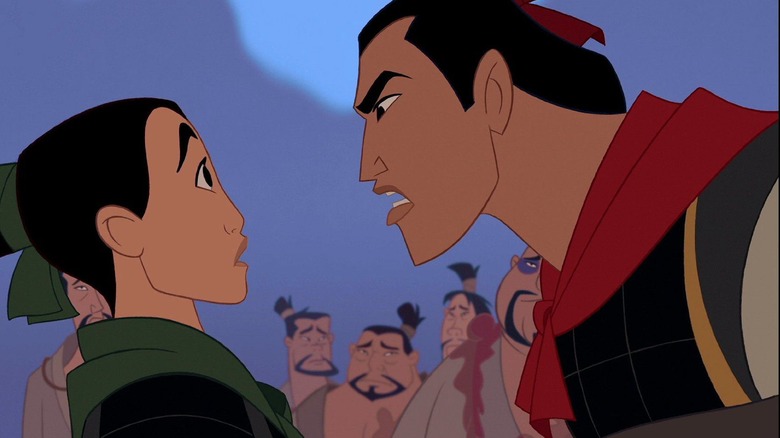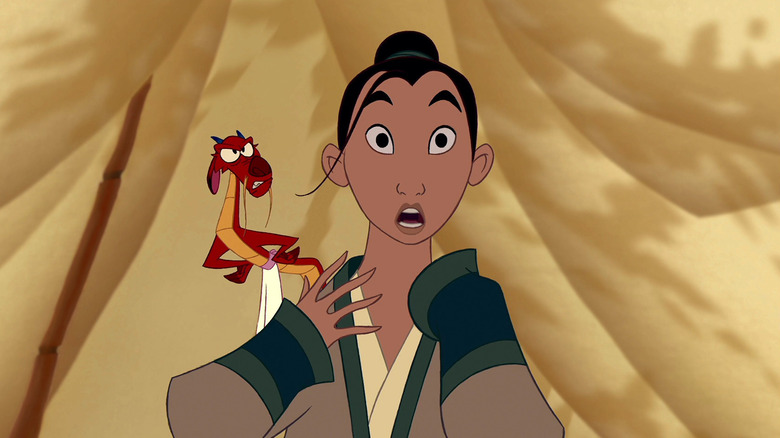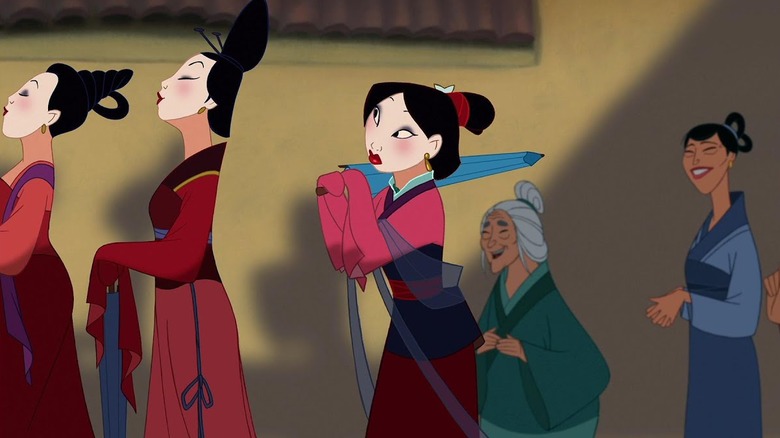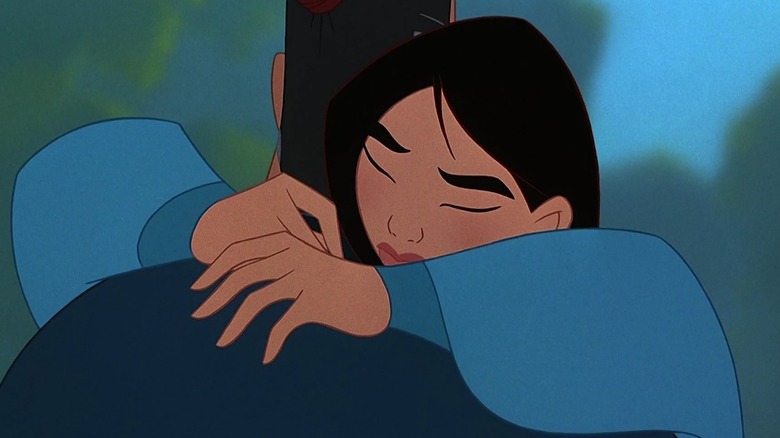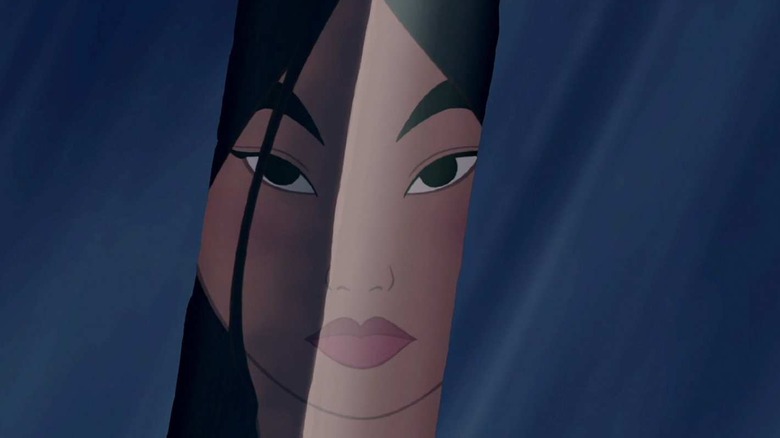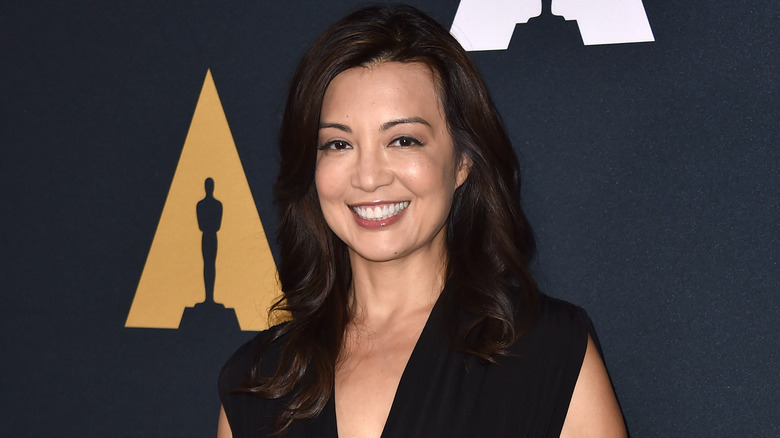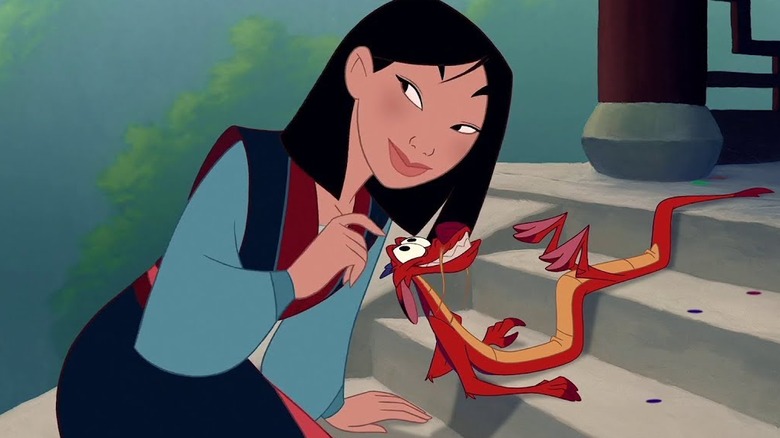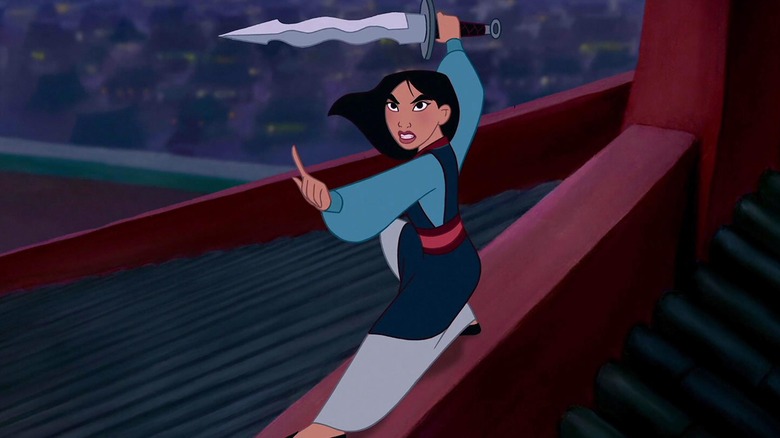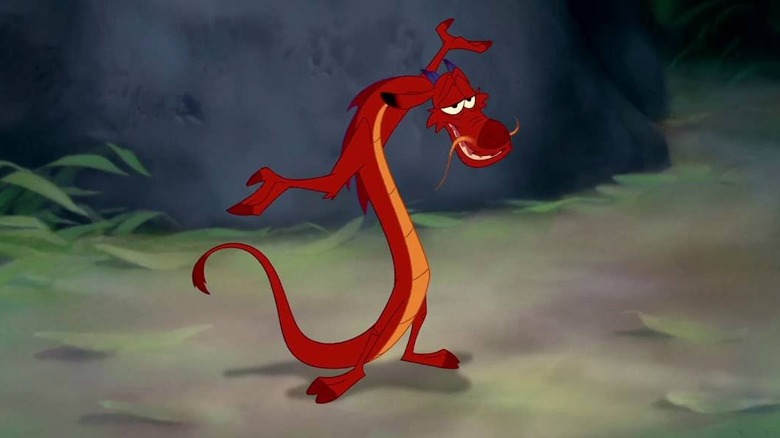How Mulan Changed Disney Movies And No One Noticed
It's been decades since Mulan first astonished audiences with her daring ambitions and yet she's just as impressive today as she was then. Who doesn't resist the urge to pump their fists when she makes the decision to dress as a man and join the army for the sake of her ailing father? Who can keep themselves from giggling when someone references bringing "dishonor on your cow?" And who doesn't crack a smile at the thought of Shang's impeccable flirtation: "You fight good?"
Despite the fact that a whole host of heroines have entered the Disney canon since the savior of China did her thing, Mulan remains special — in large part because she paved the way for those very characters. Would we have gotten Moana without Mulan? How about Merida? Would we celebrating Anna swinging a sword in Frozen 2 if Mulan hadn't done it first? Here are just a few of the ways Mulan changed Disney forever.
Disney chose a non-Western folktale and succeeded with Mulan
Superficially, Mulan is the stuff of classic Disney fantasy. A lonely young woman sets out to pursue her dreams, stumbles a bit, achieves greatness, and meets a promising beau. Our girl did all that and more — but her origin is strikingly different those of her sisters in Princessdom.
Mulan was Disney's first major attempt at crafting one of their classic musicals from a discrete, non-Western source. Aladdin comes mightily close to this feat, but it was already somewhat known in the English-speaking world as part of Arabian Nights and is itself a patchwork of retellings from all over the Middle East. Mulan, in contrast, is based on a singular story from a specific time and place. While much of the world may not have heard of Mulan or knew much about Chinese history or folklore, viewers turned out in droves — and today Mulan is as much a Disney classic as The Little Mermaid.
Mulan didn't need to end up married
Mulan ends with the merest suggestion of romance between our heroine and her prince — or, in this case, general. After he returns her helmet, Mulan is the one to ask, boldly, if he'd like to stay for dinner. They like each other, that's clear, and have earned each other's respect through feats of strength and daring moves. But instead of stamping them as Officially Together, Disney chose to end their relationship at its beginning: a first date and the hope for more to come.
Nothing else quite compares in the Disney canon, even today. Moana, Elsa, and Merida evade romance entirely in their respective movies, Anna and Kristoff end on a kiss in Frozen, and we're informed of Rapunzel and Flynn Rider's marriage in an ending voice-over in Tangled — but they likely could not have ended these ways without Mulan and Shang's unique relationship ambiguity. They're into each other, sure, but Mulan's story is, principally, just that: her story. That emphasis allowed characters like Moana to stand entirely on their own and for sisterly relationships like that at the center of Frozen to take precedence over romance. In the post-Mulan world, happily-ever-after is largely something a girl builds for herself.
Mulan proved young female characters can have specific goals
Snow White, Cinderella, and Aurora, as the original Disney Princesses, were kind-hearted heroines with big, bright dreams. Yet they are also overwhelmingly passive, and they largely bide their time wishing, waiting, and snoozing as their princes pursue them. The "Disney Renaissance," kicked off by 1989's The Little Mermaid, established a firm break with this tradition. Ariel, Jasmine, and Belle want more than their lives currently offer them, and their signature songs are all about. Belle, for instance, sings about "adventure in the great wide somewhere."
It's pretty vague beyond that, though, and their lives are often tied up in their love interests. But Mulan is different, as she has a specific goal and she achieves it. She saves her dad, her unit, and her country and then goes home as a national hero. Shang ends up part of the deal too, but he's not the goal — he's more of a perk. After Mulan, princesses started to want with specificity, from Tiana's desire to run her own restaurant to Rapunzel's longing to see the floating lanterns. Magic and romance come along for the ride too, but, nowadays, they're not the point of the entire journey.
Mulan looked different, and audiences loved it
Disney movies have always looked incredible. Snow White and the Seven Dwarves brought storybook illustration to life. The team behind The Hunchback of Notre Dame incorporated the legendary cathedral's statuaries, frescoes, and stained glass into its dizzyingly detailed frames. Beauty and the Beast used computer animation to make a simple ballroom dance into an unforgettable climax.
Mulan looked just as good, inventive, and, simply, magical. But it was the first animated Disney feature to incorporate a specific, non-Western aesthetic into its visuals to tremendous effect. Animators looked to traditional Chinese paintings for their inspiration, incorporating, as The Washington Post noted at the time of the film's release, "the delicate composition and empty space of traditional Chinese silk paintings" and making the film appear "like no other American animation." That willingness to reach beyond the Western canon would become a Disney staple, rooting everything from Lilo and Stitch to Moana in specific traditions of art. It doesn't just make these movies more accurate — it makes them utterly unforgettable.
Mulan got to keep her parents
Once upon a time, a Disney princess needed to lose at least one parent. Sometimes it was more symbolic — Aurora's parents are alive, but lost to her — but usually it was literal. This loss symbolized their rootlessness in the world and fueled their desire to find a love interest. Who needs a wicked stepmother when you can move into the castle?
Mulan, in contrast, has a family that she seeks to protect and return to. She is anchored in her own life and doesn't need another to abandon herself to. Shang, in fact, is the one who needs to impress her and her family — and, even then, his love is very much secondary to her place at home. Nowadays, a Disney princess, even if she does lose a parent, gets to keep hold of her own past and legacy. From Merida to Tiana, a princess' home and family are her own to cherish and fight for — and, if anything, it is their boyfriends seeking entrance into their worlds. The men are the cast-aside orphans now, looking to heroines for guidance and stability.
Disney wasn't afraid of using silence in Mulan
If there's one moment you remember from Mulan, it's probably the sequence in which she takes her father's sword and armor and goes to join the army in his stead. It is wonderfully animated, is the crux of the first act, and, notably, is silent. Mulan makes her pivotal choice in the dead of night, without a word to anyone.
This is a daring choice, given conventional wisdom about audience's short attention span, but it resulted in tremendous art and a powerful legacy. Would WALL-E have opened with its famously silent first act if Mulan hadn't done it first? What about the scene in which we watch Anna and Elsa lose and mourn their parents in Frozen, the silence between them growing into an uncrossable gulf? Without Mulan, these crucial moments might have been cluttered with dialogue that simply was not needed. Silence can be the most eloquent statement of all, especially where it's not expected, and it's a welcome addition to see in releases as mainstream as Disney animated films.
Mulan's actors ground the movie with culture
When creating a story rooted in a culture that is not one's own, it's best to let an expert take the lead. When it comes to large-scale productions like a Disney movie which employs hundreds of animators, writers, actors, and editors, that becomes a top priority. Without the presence of those people the movie seeks to portray, things can get awkward at best and downright insulting at worst.
Mulan, in contrast to the long history of missteps in this arena, hired many Asian voice actors for the film. Actress Ming-Na Wen won the role of Mulan after her stirring voice-over work in The Joy Luck Club, and BD Wong was chosen to play Shang. This level of thoughtfulness in casting would become the Disney standard, most recently evidenced by Auli'i Cravalho, the young Native Hawaiian woman who gave Moana her voice. Nowadays, a great cast doesn't just give their characters personality, songs, and zippy one-liners — they give them their roots as well.
Mulan showed Disney that risks can be worth it
The 1990s were a bit of an odd decade for Disney. On the one hand, culture-conquering behemoths like Beauty and the Beast took the company to grand new heights. On the other, ambitious projects like Pocahontas underperformed. The ship wasn't sinking, but it was taking on water at an alarming rate, and Disney needed a lifeboat.
Enter Mulan. Despite the fact that it was doing a number of things that had never been done before and despite the ominous portents of so-so box offices, Mulan opened to good reviews and strong numbers. This was great on its own, of course, but it also set an important precedent for Disney: Going back to "sure things" when the waters get rough isn't always the best course of action. This willingness to try new things, even in times of adversity, led to some of Disney's most spectacular triumphs, most notably Pirates of the Caribbean, which made then-CEO Michael Eisner infamously nervous. Years later, there are still new Pirates movies being made, and we have Mulan to thank.
Mulan proved heroines don't need to be princesses
Princesses are femininity incarnate, especially when it comes to their looks. Magical makeovers are common. A fabulous ballgown often makes an appearance. Songbirds flock to them. Flowers are always there to be plucked by their delicate fingers.
Mulan charged into all this loveliness like a cannonball. She is at her most uncomfortable when dolled up for the matchmaker, wiping off the makeup as she sings "Reflection" in a representation of just how false all that finery feels on her. She only truly finds herself once she's in armor, a sword in her hand, and, when she returns home as hero, she dons a simple gown of blue and red. Mulan is a lovely young woman to be sure, but she dresses simply and is more known for her skill with a blade than her dishwashing abilities. Mulan proved that a Disney heroine can go beyond the accouterments of traditional womanhood and still be beloved by Disney fans worldwide. Without Mulan, there could be no Merida, Moana, or Judy Hopps — not to mention no "I'll Make a Man Out of You" sing-alongs.
There can be comic sidekicks who aren't Aladdin's Genie
Robin Williams' Genie changed the Disney game forever. The iconic comedian brought a level of flexibility, timing, and sheer oddness no other performer could match, and his comic performance as Genie became iconic almost overnight . Audiences loved the big blue wish-granter so much that Disney began to insert similarly quippy characters into all their movies — though with diminishing returns as the 1990s wore on. The trend hit its lowest point in The Hunchback of Notre Dame with a trio of obnoxious gargoyles, whose bawdy jokes meshed oddly with the somber film around them.
Audience fatigue set in. And then, out of nowhere, came Eddie Murphy's Mushu. Unlike the gargoyles, Mushu's sunny silliness was written as a natural counterpoint to Mulan's serious determination, and many of his jokes have become bonafide classics. Mushu proved that inappropriate casting, awkward writing, and tone mismatch were the issues to be addressed, not comic relief in and of itself. Disney held fast to this lesson, and comedy from the likes of Olaf, Baymax, and the foolhardy Jumba and Pleakley flowed far more naturally than the creatures of the post-Aladdin, pre-Mulan era.
